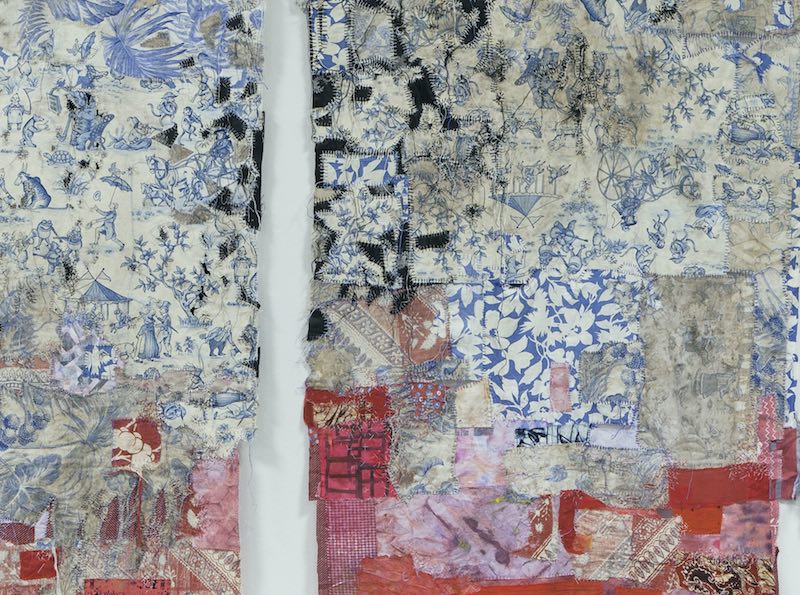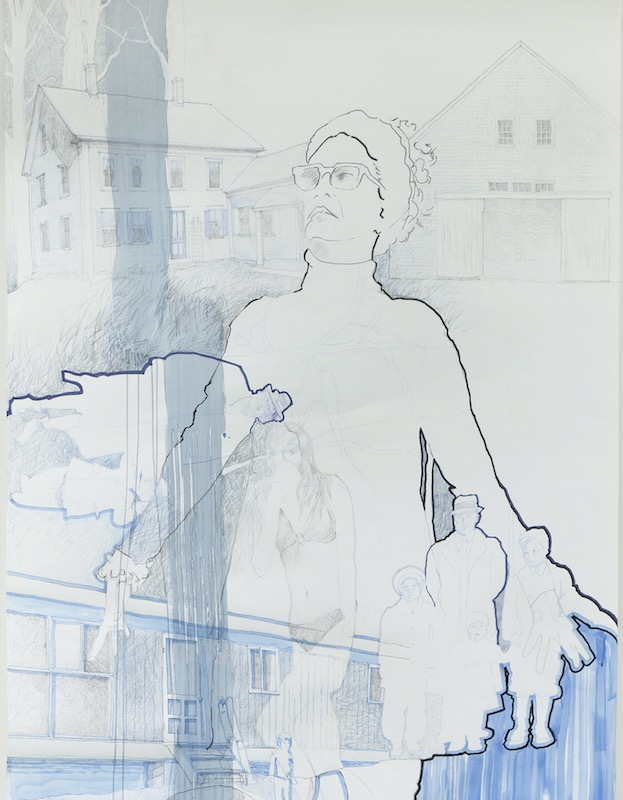Working intuitively, yet guided by design principles, Merill Comeau creates visual art that calls on her varied interests and curious nature. Any subject matter can inspire a piece that transforms disparate textiles, threads and fibers into cohesive works of art. In addition, she works with at-risk youth in secure treatment facilities, helping them find and express their creative voices.

Were you always an artist, or was there a “moment”?
I have always been a creative professional – a group that includes designers, writers, actors, as well as artists. I studied social theory, architecture, art history. And I worked in arts administration, religious education, and programming for incarcerated people. I’ve apprenticed to a craft jeweler, an antique furniture restorer, and a cabinet maker. In addition, I designed commercial and residential interiors for twenty years.
My identity as a visual artist didn’t really solidify until I turned 50 – the point at which I stopped other lines of work and focused on making art. This is the first job/career that draws from and combines all my previous experiences and a wide range of skills. So my mind, body, and heart all go into my work.


When it comes to creating, are you more of a planner or an improviser?
As an Amazon Associate I earn from qualifying purchases. Read more about our affiliate linking policy.
I am a combination of both. I am very planful about my time, goals, and commitments. So I research, think, and write about the conceptual underpinnings of my work.
My artworks, however, always seems to have a mind of their own. I may start with an image in my head, but once I’m “in the zone” of working, intuition takes over. Then materials and construction methods take the piece where it wants to go.
I work large, often on the floor. I throw down many supplies: deconstructed garments and linens, fabric I’ve painted and printed on, netting, commercial fabrics, threads and fibers. Almost immediately, visual organization then jumps out at me. Consciously and unconsciously I think and see in terms of basic 2D concepts: form, line, movement, color, value. Then as I make choices, I reinforce my overarching design ideas.


What is the significance of using repurposed textiles in your work?
I work with fabric because it is essential to our daily lives; we sleep in linens, dress in clothes, and mark life’s passages with special textiles. In addition, I inherited my family’s seamstress genes and give homage to the history of women salvaging bits of useful cloth and creating something beautiful.
I bring together incongruous fabrics redolent of past lives: mother-in-law’s blouse, worn blue jeans, cast off sheets, plastic mesh vegetable bags, vintage linens and brightly colored fabric samples of discontinued patterns. These cast offs reflect memories of lives lived, social constructs of identity and class, our speeded-up consumer cycle as well as global issues of sustainability.
Sometimes I use scraps in their original form, thus respecting the source of the rag. Other times I deconstruct and alter with paint and print, “translating” them into my visual language. Then I collage these snippets into a unified whole representing our shared human experience of coping with a complex world where we are bombarded with information and beset with challenges. My pieces are hand and machine stitched because thread gives me the ability to draw line.


How did you get started engaging at-risk youth in art? Why do you continue to do it?
This work is compelling, dear to my heart, as well as life transforming. I give public talks about this topic – my experiences in secure treatment facilities – because there are so many lessons. We can all learn from this population.
First, to encourage emerging visual voices from people who do not identify as artists, I must create a safe learning environment. My students must feel free to share and then be sure that they are heard, seen, and acknowledged. So I must be a trustworthy adult, communicate compassion, and be forgiving of peoples’ previous mistakes.
It is an honor and a blessing to have the opportunity to practice these behaviors towards others; it also strengthens my ability to show myself mercy. In addition, I’ve learned from youth a great deal about the importance of dreams and hopes as well as finding the ability to act with optimism and resiliency in the face of crisis.

Is there an overarching theme that connects all of your work? What is it about a subject that inspires you to continue exploring it?
It is hard for me to condense my work down to one theme, so much of the analysis of my entire body of work I leave to those with a curatorial and/or art history lens. I have heard from professionals that they perceive a through line of connection. I’ve received comments recognizing themes of life’s fragility, persistent presence of memory, honoring women’s history, finding beauty in decay, celebrating the ephemeral, as well as translating traditional craft to express contemporary concerns.
Not a theme, but a consistent impulse I feel is to create work that reflects common human concerns. The work visually communicates those concerns in a way that facilitates conversations and experiences that forge connections.


What do you do differently? What is your signature that makes your work stand out as yours?
I don’t focus specifically on being original as a goal. In my design education, we were taught there is nothing new under the sun. So every form, shape, color, pattern already exists and is ready to be plucked as inspiration.
I look at science, literature, dance, nature, architecture — so everything I see and read is fodder for my imagination. As an artist it is my job to translate, bend, and incorporate stimuli to speak what I want to say. If you look at my physical product, you would be hard pressed to see explicit sources. The act of creation and the processes I employ alter and transform them to create something new.


Can you tell us about the inspiration and process of a work that stretched you as an artist? How does a new work come about?
Commissions, topic requests, and responding to context (institutions, communities, historic sites) stretch me in new directions. Every challenge expands my use of colors, vocabulary of imagery, facility with abstraction, and narrative threads to explore. An example is my recently completed 15’w x 6’h commission for a hospital; I worked on a base of enlarged copies of thank you notes from patients. In addition to painting and collaging symbolic healing flora, I stenciled words collected from the hospitals health care staff; they described characteristics they see in themselves and their patients that promote healing and recovery.

Tell us about your website. What do you hope people will gain by visiting?
I want to be findable and accessible; my website serves both purposes.
My website showcases only a portion of my work; so it serves as a glimpse into my capabilities and hopefully causes the viewer to feel curiosity. People can hire me to teach, speak, create commissioned work, present me to others and/or request access (studio visit, sale).
My website is also a notice board of my exhibitions, articles in periodicals, and/or my workshops.

What advice would you give to emerging artists?
Don’t let people discourage you because of the potential income limits. There are many related jobs in arts administration, education, and community programming to support you as you build your practice.
Being an artist is a lifestyle as well as a career. Be a person that is planful about studio time; devise strategies to keep your self-directed artmaking going in the evenings and weekends. Create and/or join artist groups; surround yourself with generous people who support your efforts, remind you that you are an artist and inspire you to keep making.
Apply, apply, apply to things. And keep in mind that if you get one yes for every twenty rejections you receive… that is a great ratio and means you are doing well. One special opportunity for creative folks is the extensive international array of artists residencies available to you. So research to see if you can find one that fits your schedule, apply, and attend.
And remember, everything you make will not be a masterpiece. Often, you will find that you do not like your output. Turn that discouragement into energy that propels you to make the next, better piece.
Interview posted November 2020
Browse through more inspirational Spotlight interviews on Create Whimsy.
